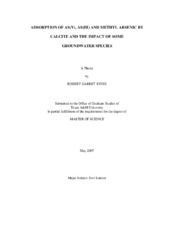| dc.description.abstract | The objective of this research was to investigate the retention of arsenate (iAsV),
arsenite (iAsIII), monomethyl arsenate (MMAsV) and dimethyl arsenate (DMAsV) by
calcite and assess the impact of dissolved Ca2+, Mg2+, phosphate and sulfate on arsenic
solubility, adsorption and precipitation phenomena.
Adsorption kinetics of iAsV, evaluated at a low and high concentration, was a
relatively rapid process, with a fast initial reaction rate within the first few minutes and a
subsequent slower reaction rate as equilibrium was approached. The relative adsorption
of arsenicals decreased in the following order: iAsV > iAsIII > DMAV > MMAV. In no
case was a clear adsorption maximum observed with increasing dissolved arsenic
concentration. Dissolved 0.01 M Ca2+ resulted in an increase in iAsV adsorption;
however, in the presence of 0.1 M Ca2+ adsorption of iAsV was decreased. The presence
of Mg2+ as 0.01 M Mg(NO3)2 resulted in decreased iAsV adsorption probably the result of
a lower iAsV affinity for adsorbed Mg2+ as compared to Ca2+. Phosphate and sulfate were
highly competitive with iAsV in adsorption to calcite and both resulted in decreased iAsV
adsorption. The total prevention of iAsV adsorption at initial equimolar arsenic/phosphate
concentrations > 88 µM each could be from the consumption of available calcite surface sites by the specific adsorption of phosphate. Equilibrium modeling, using the
geochemical and mineral speciation of equilibrium model (MINTEQA2), indicated that
at low concentrations of arsenate or phosphate solid-phase precipitation was not likely
and adsorption processes likely controlled solubility. At high concentrations of arsenate
Ca3(AsO4)2 · 3 2/3 H2O and Ca3(AsO4)2 · 4 1/4 H2O solid phases could be controlling
arsenate solubility.
This study indicates that arsenic adsorption response by calcite was different than
that of phosphate suggesting that arsenic may not be specifically adsorbed to calcium at
the calcite surface. Reduction and biomethylation of arsenic decreased adsorption,
suggesting that processes which could affect the speciation of arsenic in the environment,
could increase arsenic mobility in environmental systems where calcite and dissolved
aqueous calcium play a predominant role in controlling arsenic solubility. Dissolved
aqueous concentrations of magnesium, phosphate and sulfate generally reduced the
ability of arsenic to be adsorbed to calcite. | en |


